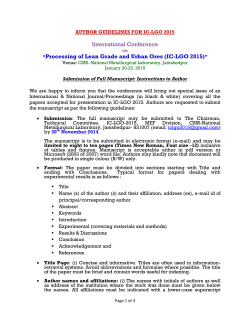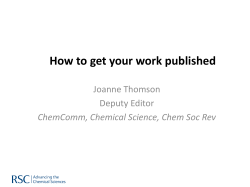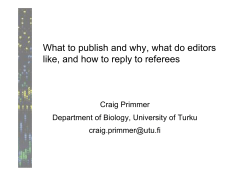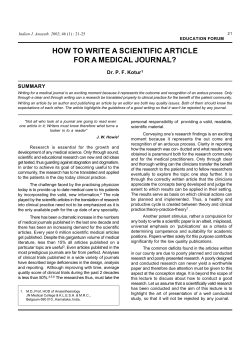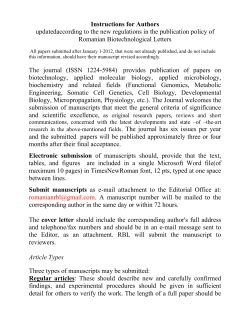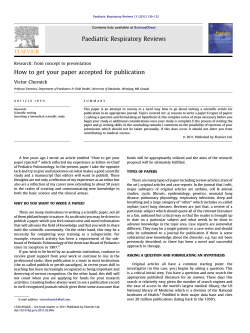
Document 159906
How to Write a Paper for Publication Franklin L. Rosenfeldt MD, FRACS,l John T. Dowling Meryl J. Fullerton FRACP,~ Salvatore ~sc~ Pepe PhDl and lCardiac Surgical Research Unit, Alfred Hospital and Baker Medical Research Institute, 2Royal Melbourne Melbourne, Australia, 3StafJwriter, Heart Lung and Circulation Hospital, Engaging in the scientific publication process can be for both altruistic and egotistical reasons; publication advances the state of scientific knowledge while advancing your institution and your career. Writing for publication means setting aside a location and time dedicated entirely to the process of planning and writing. It is easiest to begin with the Methods section, then the Results, followed by the Discussion, which is the most challenging part of a paper. A realistic assessment of the value of the article will determine the level of journal into which it is likely to gain acceptance. If your article is rejected by a journal, be consoled by the fact that 50% of articles that are initially rejected are eventually published. Following the steps outlined here can reduce the daunting task of writing to one of manageable proportions and can help overcome the mental block and procrastination that all of us have experienced when we set out to write a scientific paper. (Heart, Lung and Circulation 2000; 9: 82-87) Key words: publishing, writing. W riting a scientific paper and seeing it through to publication in a peer-reviewed journal is a major endeavour; it also represents a daunting challenge, especially for the inexperienced writer. As a worldwide group, cardiothoracic surgeons are poorly represented in the scientific literature. Despite their undoubted clinical and technical excellence, this lack of representation applies equally to cardiothoracic surgeons in Australia and New Zealand, as illustrated by the number of publications authored by these cardiothoracic surgeons compared with those of Scandinavia1 for the period 1993-1997. A careful Medline search revealed that Australasian surgeons published a total of 186 papers, only half the 389 published by Scandinavians, both regions having similar populations and economic status according to 1990 census figures. Of additional concern is that only 33 of the 186 Australian publications had surgeons as their primary authors. The reality is that the 60 cardiothoracic surgeons operating in Australia for that period had an average publication rate equivalent to Correspondence: Assoc. Prof. EL. Rosenfeldt, Editorial Office, Department of Cardiothoracic Surgery, Alfred Hospital, PO Box 315, l’rahran, Victoria 3181, Australia. Email: f.rosenfeldt@alfred.org.au only one primary paper per surgeon every 8 years. We suspect that Australian and New Zealand cardiologists are more prolific authors than their surgical counterparts but have no data on this point. In an earlier publication we discussed some of the reasons why clinicians engage in the publication process and also considered the mechanics of writing for publication.2 The present paper aims to be an additional guide to the various steps and hurdles encountered in producing a manuscript and eventually having it published. Reasons for Writing There are many reasons to write: to advance and disseminate knowledge, to advance your institution and to advance your career. Advancing Knowledge If you believe you have something worthwhile to say then publication in a peer-reviewed journal is the most far-reaching means of communication. This presupposes that you have new scientific data (original ‘research), a novel clinical finding (case report) or a new insight or interpretation of existing knowledge (review article). Heart, Lung and Circulation How to Write a Paper et al. 2000; 9 83 F. L. Rosenfeldt Remember, research is not research until it is published in a refereed journal. Advancing Your Institution High-quality publications can advance the prestige, and ultimately the funding of your department or institution. Assessments of the collective research output of your institution in terms of the quality and quantity of publications affects the degree of financial and other support for your institution generated by private, corporate and government sources. In addition, clinical units that are seen to publish their clinical and research achievements are naturally more attractive to top class clinical trainees. Advancing Yourself Publication of material in your professional area increases your promotional opportunities. Something that can place you above a crowd of other applicants for promotion is a curriculum vitae that includes publications in refereed journals. The fact that you have been able to complete and publish your research findings indicates to a promotions panel that you have what it takes to be given a position of greater reward and responsibility, for you have shown yourself to be a highly motivated, thinking individual who can carry projects through to completion. Achieving Promotion Enhancing your Profile Participation in research programs raises your profile within and outside your immediate professional community. Producing substantial numbers of significant publications during your career enhances your reputation, but more important is the immense satisfaction that comes from seeing your work quoted by others in the ongoing literature in your specialty. your Research Ability Writing about your work makes you a better researcher. The very act of writing for publication imposes a discipline that forces issues to be thought through in a logical way, allowing you to detect the weaknesses in an argument. Furthermore, the discipline of preparing to write - involving searching the literature to ensure your idea has not already been fully explored - is a worthwhile exercise that improves your own knowledge and can lead to the generation of ideas to be followed up later - again, ultimately making you a more effective researcher. Increasing National and International Recognition Achieving publication has flow-on effects that can benefit your career long-term through the establishment of national and international exchanges. Improvements in the Gaining quality of your work can follow, through the sharing of ideas and the establishment of collaborations. Admission to either fellowship in surgery or membership in cardiology now encompasses more stringent research requirements including presentation, and importantly, publication of original research. Inevitably, higher publication requirements will apply to the next generation of physicians and surgeons, as training in research and writing gives impetus to continuing publication. In today’s world of evidence-based medicine, a clinician’s ability to critique research publications, discern the nature and quality of the scientific content and interpret its significance is a crucial skill; one that is greatly enhanced by conducting research and especially by writing it up for publication. What to Write There are several types of scientific paper: a case report, a report of a clinical trial, a how-to-do-it report (a new surgical or biochemical technique), a review article or a laboratory research paper. Whatever type of paper you write, explain all abbreviations at first mention, even in the Abstract, and avoid the use of cliches, jargon, colloquialisms and slang. How to Start Before you begin the writing process, decide which journal will receive your completed masterpiece. This is important because the amount of detail allowed in the Methods section, the acceptable length of the entire manuscript, the formatting of text and references, page charges and costs for colour photographs vary from journal to journal. All these criteria are defined in the Instructions for Authors that are printed regularly in all journals and are usually available on a journal’s website. Once you are in a position to write the paper it is important to be able to focus exclusively on the task. Make a time to clear the mind and concentrate on that first session of writing, then allocate further times at regular intervals to revisit the issue. A good way to keep the work progressing is by arranging regular meetings with co-authors and setting goals to be reached before each meeting. We can attest to the value of this discipline in writing the article you are now reading. As you begin, you must face the tyranny of the blank page - a major cause of procrastination. The first step is to get something down. Begin with a plan. Make headings and subheadings. A useful approach is to prepare several sheets headed, Introduction, Methods, Results and Discussion. Fill these with all your ideas and data. These sheets are your reservoirs. Next, organise these reservoirs 84 How to Write Heart, Lung and Circulation a Paper into an orderly plan with headings and subheadings numbered la, b, c, 2a, b, c, etc. You should already have your results so use these to construct some rough diagrams and tables. In sketching out the figures and tables that illustrate the results, take time to consider the way you might best present the data with clarity, with emphasis on the novel nature of the findings and how they advance the field. The Anatomy of a Manuscript With the exception of reviews, case reports and hypothesis papers, scientific papers normally use the same format: Title, Abstract, Introduction, Methods, Results, Discussion and References. To put yourself in the writing mood, give your paper a temporary title. This helps you to see the paper as a tangible object and assists with a sense of moving forward on the project. Methods Section Write this section first, dividing the material into subsections that describe the use of: (i) human or animal subjects, (ii) techniques and (iii) statistics. When discussing the use of human or animal subjects, give details of the numbers of subjects used, the subject groupings created, the exclusion and inclusion criteria and the obligatory requirement of most journals for a statement indicating that permission for your study has been granted by the appropriate ethics committee. When discussing the use of techniques, give enough detail to allow the experimental methods to be repeated by others, or alternatively provide references in which full details of the technique can be found, and limit your writing to a description of the modifications you have incorporated into those methods. When discussing statistics, both readers and reviewers of your manuscript need a clear explanation of the statistical methods used in the design of the study and in the analysis of the results so as to be able to gauge the validity of the findings. If at all possible engage the assistance of a professional statistician, even if this involves a fee. The best designed studies are those that have had the benefit of a statistician’s advice before the start of the experimentation phase. Indeed, all studies need careful statistical design before the start of data collection. Next, go on to complete the Results, Discussion, Introduction, References, Abstract and revised Title, in that order. ures and be sure to give sufficient detail in the text to present each result in the context of the other study findings. Results should provide information on mean values plus an index of spread (e.g. the standard error of the mean (SEM) or standard deviation (SD), together with indications of statistical significance. There should be clear statements about similarities or differences demonstrated by the data. Results may be presented as statements in the text, as graphs, line diagrams or tables (the latter is best for complex results with many parameters). For maximum impact present the central findings of the study in graphical form. Keep graphs simple, designing them to eliminate all extraneous material. Textual material provides precise and detailed information about the data, but its immediate impact is low. Tables organise the data into a more accessible form, giving the data greater impact than text, with precision being maintained. Graphing the data has the advantage of clarity and impact, and can bring out relationships between various parameters. Illustrations can have great impact but may be unable to convey a clear message. Usually a professionally produced line drawing is more comprehensible than a photograph. The merits and demerits of the various ways of presenting your results are summarised in Table 1. All graphs, photographs and diagrams should be accompanied by figure legends, set out on a separate page. Note that costs of colour illustrations are normally borne by the author and not the publisher. Discussion Section The Discussion is the most difficult section to construct. You will have read the literature by now, you are thoroughly familiar with recent advances in the field and you are therefore ready to evaluate your results critically. Remember that the first to see your manuscript will be the reviewers who make the allimportant decision about whether the paper is acceptable for publication. The Discussion should be written with a sense of flow and with care being taken to avoid reiterating results - something that might bore your readers. Crucial to the writing process is the elimination of ambiguity in the text. A way of giving flow to the Discussion is to discuss your findings under a number of headings. Table 1. The characteristics of four possible modes of data presentation in scientific publications. Results Section Be careful to include only data in this section, 2000; 9 F. L. Rosenfeldt et al. not the background findings that led to the data. Background material should appear in the Discussion section or in the Introduction. In writing the Results section use your rough set of results and figures as a guide. Augment the information presented in each of the fig- Content Precision Impact Interest Text Table Graph Illustration +++ +++ + + ++++ +++ ++ ++ ++ ++ ++++ +++ + + +++ ++++ Heart, Lung and Circulation How to Write a Paper F. L. Rosenfeldt et al. 2000; 9 These could be listed briefly at the outset and then expanded, taking each issue in order and giving it a separate paragraph. The particular significance or originality of each finding should be emphasised here. Broadening the subject to address the wider field and indicating how the presented findings either fit with or enhance knowledge of the area rounds out the text. End the Discussion with a summary paragraph incorporating a conclusion. This should give an indication of any implications for clinical practice and possible directions for future research by flagging questions arising from your study. Introduction The Introduction should consist of a very general first paragraph putting the case for the importance of the topic and referring to the major findings already published in the area. An argument for your having undertaken this particular study should follow and this should include a statement about the hypothesis to be tested or the specific questions that you feel need to be answered, with reference made to any conflicting views or issues in the literature. Finally, outline your chosen approach to answering those questions. References Reference lists are formatted according to the journal’s author instructions. The use of a computerised referencing system such as Endnote@ can make this task a relatively simple one and has the added benefit of allowing you to change the formatting quite simply if your paper suffers rejection from one journal and requires reformatting for another. Reference lists usually contain up to 40 citations for a clinical or laboratorybased paper and more for a review, perhaps in the hundreds. Once again, check the Instructions for Authors, as space considerations now mean very strict total word limits in many journals. Be sure to check the accuracy of the reference list. With the use of the latest version of reference manager programs, references can be downloaded from Medline or PubMed directly into your files so that the errors of transcription that have plagued published work for so long should now be largely eliminated. Abstract The abstract is generally given a strict word limit by publishers, usually around 250 words, so be sure to acquaint yourself with the journal requirements. In constructing the Abstract mention all the important concepts contained in the paper, including a background and introductory statement, the main methods used, the main results and conclusion. Keep in mind that PubMed and Medline databases, as part of their indexing procedures, use both Title and Abstract plus any extra key words you supply. Sometimes the Abstract appears in the form of a single paragraph and sometimes it is struc- 85 tured by division into the sections appearing in the text, Introduction, Methods, Results and Discussion. Note that statements made in the Abstract are not referenced, in contrast to the main text where every statement you have derived from other publications must be referenced. Title Think ‘readability’ when you are considering the title. It must rapidly convey an idea or information so that it will capture the immediate attention of the reviewer and reader. A pithy, positive statement of your main finding makes a catchy title. The title may be in the form of a question. The axiom of title readability and impact applies especially to those journals that tend to attract library browsers, generally the non-specialist journals like the British Medical Journal, New England Journal of Medicine and Lancet. Remember that the whole of the abstract and title are used by Medline or Pubmed to source key words for their indexing process. How to Finish At some stage during the writing period you should present your research findings at a national or international meeting. Presenting your work to an expert and critical audience raises issues you may have overlooked and which may be raised by journal referees. This strategy may help you cut down the number of revisions required, particularly after submission to a journal. Indeed, it may help avoid rejection! Preparing the Final Draft Although the first draft of the manuscript has taken a huge commitment of time and energy, you must realise that there are many more drafts to come. Realistically, any number between five and 20 drafts (this paper ran to 12 drafts) may be necessary to work the basic structure into a polished whole, especially if there are to be multiple authors. For this reason it is often preferable to have the main process undertaken by one or two of the authors, with other contributors engaged at the later stages of the process more for comment and critical analysis than for the provision of large amounts of text. Give a reasonably complete draft to one or more of your colleagues experienced in writing. It is amazing what glaring errors cannot be seen by authors who have read the paper in previous drafts. Also, if possible, put the manuscript aside and do not read it for a week and then look at it with fresh eyes. This is always a salutary process. Always make sure all authors sight the final draft or an almost final draft before it is submitted for publication. Many journals require all authors to sign a form to say they have viewed the final version. 86 How to Write Heart, Lung and Circulation 2000; 9 a Paper F. L. Rosenfeldt et al. Targeting the Market Place Before sending your manuscript to a journal editor, you will need to make a realistic assessment of its value in the publishing market place. For novice writers it is wise to seek the opinions of others more experienced at the writing process. These will be able to give an objective assessment of the realistic merits of your hard-won piece of written science. Effective analysis of the market for placement of a particular paper and high standards of research and writing are central to avoiding the pain of rejection and resubmission. Minimum pain involves the dent to the ego, the delay in publication and the necessity for simply reformatting an article before submitting it to a different journal. This can occur if you have misjudged the journal’s level of interest in your topic or in the style of article you have sent. Check the Instructions to Authors and recent Tables of Contents to determine the level of interest for your topic in other journals. More pain comes with having to re-analyse your data or collect more in order to prepare for resubmission to the original journal or to a different journal. Maximum pain accompanies outright rejection from even a low impact journal. An appreciation of the system of journal ranking via their impact factors is very helpful in deciding where your manuscript should be directed. The impact factor of a journal is available through the Science Citation Index, published annually by the Institute for Scientific Information, USA. Impact factors are determined by the ratio of the number of citations of papers from that journal in the whole of the biomedical literature over a 2 year period, to the total number of articles published by the journal in that 2 year period. Thus, the small sized journal which concentrates on publishing review-type articles (more frequently cited than papers arising from data generation) is likely to have a higher impact factor than the large journal that publishes mainly data-derived research papers. It is important also to work out where your research would best fit, in relation to the publishing objectives of the many possible journals available.3 For example, check, by reading the instructions to authors, that your journal of choice actually publishes case reports if this is what you are offering. Novice writers are more likely to have their early research work published with minimum pain in journals that have not yet entered the Science Citation Index’s list of journal citation reports, in journals with low impact factors or in younger refereed journals, such as this one. high of presented manuscripts being accepted first time round. The typical flow path for a manuscript, from initiation to publication is shown in Fig. 1. If you are in the fortunate position of having the manuscript accepted subject only to reviewer’s changes being incorporated, get advice as to how to incorporate these required changes .with the least pain. Sometimes a criticism of the paper by a reviewer can arise because you have offered inadequate explanation for a point within the text, so a rewrite of that section may be all that is required. It is extremely important to answer each and every one of the reviewer’s questions and criticisms. Start by numbering them all, address each one, either by modifying the text or, if appropriate, by objectively pointing out potential misinterpretation by the reviewer. Sometimes, as a condition of acceptance, the reviewers may require further work to be done. You have a choice of doing the work or trying your luck with another journal and that means reformatting the paper for the new presentation. If the reviewers do reject the paper, take notice of the criticisms and use them in I (not uncommon) I With rejection rates climbing (currently 70% for Car&oResearch (impact factor ~.CI)),~the chances are not (usual) I I The Rejected ArticIe vascular I First draft I of I I PUBLISHED JOURNAL ARTICLE Figure 1. Typical jlowcharf manuscript. of a I_ I I the development and refining How Heart, Lung and Circulation 2000; 9 to Write a Paper 87 F. L. Rosenfeldt et al. making the manuscript more publishable before sending it elsewhere. Reviews from a high-quality journal are generally very helpful in the ‘refinement’ process that precedes final acceptance. Occasionally, if you are able to answer every criticism you might resubmit to the same journal. Perseverance may pay! What To Do With Your Rejected Manuscript? Be consoled by studies of the editorial and review process completed for the Journal of Clinical Investigation5 and Journal of Laboratory and Clinical Medicine6 which demonstrated a wide range of reviewers’ opinions for the same test papers. For the study completed by the Journal of Clinical Investigation the priority rating ranged from a high rating to rejection for a single paper that addressed a controversial topic. By extrapolation, papers sent to other journals are likely to suffer in the same way, because the review process is such a subjective one. Be consoled too by the findings of a study that determined that around half of papers rejected from one journal found their way to publication in other journals, albeit mostly of a lower impact factor.4 The figure of half is likely to have been an underestimate given that not all journals are listed on any one database. Submitting your rejected and rewritten manuscript to another, and preferably less prestigious, journal is a good decision to make, and hopefully sooner rather than later - before depression sets in! Although having your work published in a journal indexed on the Science Citation Index is the preferred option for gaining greatest status for your publication, it is always of value for the career path and general status of new writers to publish in a refereed journal, even if it is not included in the Science Citation Index and Impact Factor listings. It is worth noting that 40% of scientific journal articles published in Australia do not appear in journals listed in the Index for Scientific Information (ISI). Generally, it is easier for an author to publish in journals that are not very widely known, often because these publications are new to the scientific publishing area or of restricted distribution. So take courage, take up your pen, turn on your computer and start writing! References 1. Rosenfeldt FL. Cardiofhoracic Surgery in Australia: a Critical Review. RACS Foundation Lecture, Brisbane 1997. 2. Grigg MJ, Rosenfeldt FL. Writing a surgical paper: Why and how? Ausf. NZ. 1. Surg. 1990; 60: 6614. 3. Schien M, Fingerhut A. Where can surgeons publish? Br. 1. Surg. 2000; 87: 2614. 4. Opthof T, Furstner F, van Greer M, Coronel R. Regrets or no regrets? No regrets! The fate of rejected manuscripts. Cardiovasc. Res. 2000; 45: 255-8. 5. Scharschmidt BE DeAmicis A, Bacchetti I’, Held MI. Chance, concurrence, and clustering. Analysis of reviewer’s recommendations on 1000 submissions to the Journal of Clinical Investigation. J. Clin. Invest. 1994; 93: 1877-80. 6. Ernst E, Resch K-L. Reviewer bias: A blinded experimental study. 1. Lab. Clin. Med. 1994; 124: 178-82. 7. National Board of Employment, Education and Training (NBEET). Q uanfifafive lndicafors of Australian Academic Research, Commisioned Report No 27. Australian Government Publishing Service, Canberra, 1994.
© Copyright 2025
